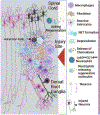Neutrophil biology in injuries and diseases of the central and peripheral nervous systems
- PMID: 37355220
- PMCID: PMC10528432
- DOI: 10.1016/j.pneurobio.2023.102488
Neutrophil biology in injuries and diseases of the central and peripheral nervous systems
Abstract
The role of inflammation in nervous system injury and disease is attracting increased attention. Much of that research has focused on microglia in the central nervous system (CNS) and macrophages in the peripheral nervous system (PNS). Much less attention has been paid to the roles played by neutrophils. Neutrophils are part of the granulocyte subtype of myeloid cells. These cells, like macrophages, originate and differentiate in the bone marrow from which they enter the circulation. After tissue damage or infection, neutrophils are the first immune cells to infiltrate into tissues and are directed there by specific chemokines, which act on chemokine receptors on neutrophils. We have reviewed here the basic biology of these cells, including their differentiation, the types of granules they contain, the chemokines that act on them, the subpopulations of neutrophils that exist, and their functions. We also discuss tools available for identification and further study of neutrophils. We then turn to a review of what is known about the role of neutrophils in CNS and PNS diseases and injury, including stroke, Alzheimer's disease, multiple sclerosis, amyotrophic lateral sclerosis, spinal cord and traumatic brain injuries, CNS and PNS axon regeneration, and neuropathic pain. While in the past studies have focused on neutrophils deleterious effects, we will highlight new findings about their benefits. Studies on their actions should lead to identification of ways to modify neutrophil effects to improve health.
Keywords: Chemokine; Nerve injury; Neutrophil; Neutrophil extracellular trap; Phagocytosis; Polymorphonuclear leukocyte; Wallerian degeneration.
Copyright © 2023 Elsevier Ltd. All rights reserved.
Conflict of interest statement
Declaration of Competing Interest The authors have no conflict of interests to disclose.
Figures







Similar articles
-
Neurotrauma and inflammation: CNS and PNS responses.Mediators Inflamm. 2015;2015:251204. doi: 10.1155/2015/251204. Epub 2015 Mar 31. Mediators Inflamm. 2015. PMID: 25918475 Free PMC article. Review.
-
Wallerian degeneration: gaining perspective on inflammatory events after peripheral nerve injury.J Neuroinflammation. 2011 Aug 30;8:110. doi: 10.1186/1742-2094-8-110. J Neuroinflammation. 2011. PMID: 21878126 Free PMC article. Review.
-
Immune Cell Biology in Peripheral Nervous System Injury.Neurorehabil Neural Repair. 2025 Mar;39(3):230-240. doi: 10.1177/15459683241304325. Epub 2025 Jan 2. Neurorehabil Neural Repair. 2025. PMID: 39744962 Review.
-
Differential macrophage responses in the peripheral and central nervous system during wallerian degeneration of axons.Exp Neurol. 1995 Dec;136(2):183-98. doi: 10.1006/exnr.1995.1095. Exp Neurol. 1995. PMID: 7498408
-
The transitional zone and CNS regeneration.J Anat. 1999 Feb;194(Pt 2)(Pt 2):161-82. doi: 10.1046/j.1469-7580.1999.19420161.x. J Anat. 1999. Corrected and republished in: J Anat. 2000 Jan;196 ( Pt 1):137-58. PMID: 10337949 Free PMC article. Corrected and republished. Review.
Cited by
-
Neutrophils in glioma microenvironment: from immune function to immunotherapy.Front Immunol. 2024 May 8;15:1393173. doi: 10.3389/fimmu.2024.1393173. eCollection 2024. Front Immunol. 2024. PMID: 38779679 Free PMC article. Review.
-
Astrocyte-derived CCL5-mediated CCR5+ neutrophil infiltration drives depression pathogenesis.Sci Adv. 2025 May 23;11(21):eadt6632. doi: 10.1126/sciadv.adt6632. Epub 2025 May 21. Sci Adv. 2025. PMID: 40397747 Free PMC article.
-
Exploring Molecular Pathways in Exercise-Induced Recovery from Traumatic Brain Injury.Med Sci Monit. 2025 Apr 12;31:e946973. doi: 10.12659/MSM.946973. Med Sci Monit. 2025. PMID: 40219599 Free PMC article. Review.
-
Immune cell contribution to vascular complications in diabetes.Front Endocrinol (Lausanne). 2025 May 21;16:1549945. doi: 10.3389/fendo.2025.1549945. eCollection 2025. Front Endocrinol (Lausanne). 2025. PMID: 40469434 Free PMC article. Review.
-
Neutrophils in Ocular Diseases.Int J Mol Sci. 2024 Jul 15;25(14):7736. doi: 10.3390/ijms25147736. Int J Mol Sci. 2024. PMID: 39062975 Free PMC article. Review.
References
-
- Ahuja SK, Lee JC, Murphy PM, 1996. CXC chemokines bind to unique sets of selectivity determinants that can function independently and are broadly distributed on multiple domains of human interleukin-8 receptor B. Determinants of high affinity binding and receptor activation are distinct. J Biol Chem 271, 225–232. 10.1074/jbc.271.1.225 - DOI - PubMed
-
- Ahuja SK, Murphy PM, 1996. The CXC chemokines growth-regulated oncogene (GRO) alpha, GRObeta, GROgamma, neutrophil-activating peptide-2, and epithelial cell-derived neutrophil-activating peptide-78 are potent agonists for the type B, but not the type A, human interleukin-8 receptor. J Biol Chem 271, 20545–20550. 10.1074/jbc.271.34.20545 - DOI - PubMed
-
- Allport JR, Ding H, Collins T, Gerritsen ME, Luscinskas FW, 1997. Endothelial-dependent mechanisms regulate leukocyte transmigration: a process involving the proteasome and disruption of the vascular endothelial-cadherin complex at endothelial cell-to-cell junctions. J Exp Med 186, 517–527. 10.1084/jem.186.4.517 - DOI - PMC - PubMed
-
- Amaral FA, Costa VV, Tavares LD, Sachs D, Coelho FM, Fagundes CT, Soriani FM, Silveira TN, Cunha LD, Zamboni DS, Quesniaux V, Peres RS, Cunha TM, Cunha FQ, Ryffel B, Souza DG, Teixeira MM, 2012. NLRP3 inflammasome-mediated neutrophil recruitment and hypernociception depend on leukotriene B4 in a murine model of gout. Arthritis Rheum 64, 474–484. 10.1002/art.33355 - DOI - PubMed
Publication types
MeSH terms
Grants and funding
LinkOut - more resources
Full Text Sources
Miscellaneous

